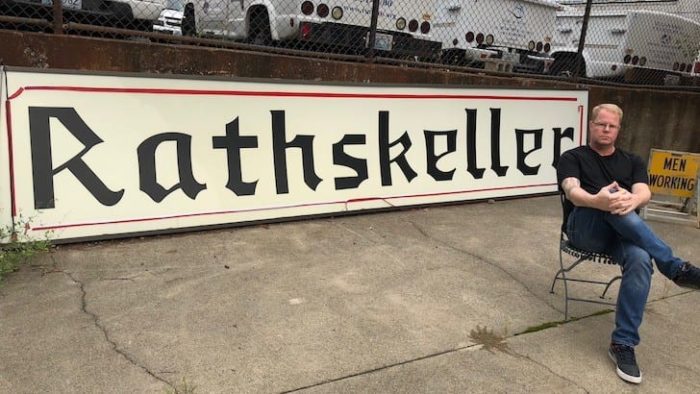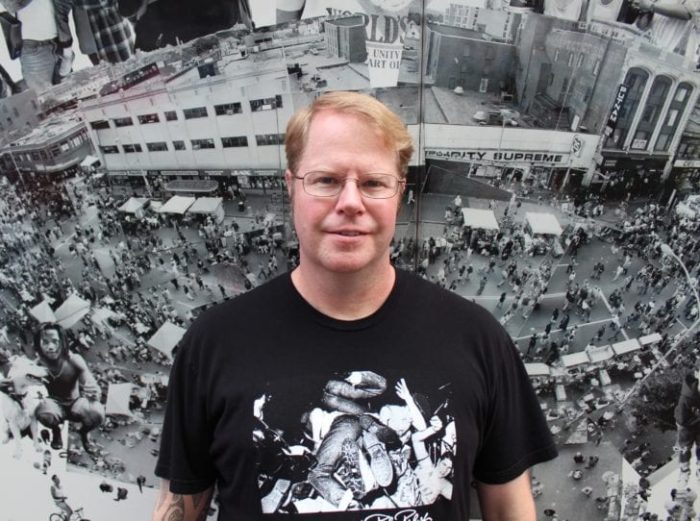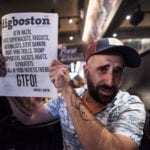
There are many things that came to mind when brainstorming approaches to this piece about my old friend and accomplice Brian Coleman, but none more than that he… takes… his… time.
Not his sweet-ass time, as that phrase has a nasty connotation. Just… his… time. Something that most of us in the writing game don’t have the luxury of enjoying these days.
But not Coleman. He took his time to interview hundreds of iconic producers and rap artists for books in his Check the Technique series—for years, he even painstakingly transcribed his analog interviews in notebooks by hand before rewriting them on computer. And most recently, Coleman has been turning pages of old newspapers and magazines spelunking for unique ads in service of his latest project, Buy Me, Boston, which he describes as a “stream-of-consciousness visual tour through late 20th-century Boston.”
True to his patient nature, for Buy Me, Boston Coleman sorted through pubs, including the Bay State Banner, the Real Paper, and even vintage Boston Red Sox yearbooks, to select about 400 ads that made the final cut. Like I said, the guy is in… no… rush. That’s for the better, as he’s plucked and unearthed essential goodies that were shot and illustrated to push everything from long-forgotten venues to enduring institutions like WGBH.
“I didn’t want to do another hip-hop book, but I like doing books,” Coleman told me. “Even though they’re not the easiest thing to do, it’s my first impulse.”
With his circus of a book release party coming to the Brattle Theatre this Sunday, Nov 11, and featuring everything from forgotten dusty clips to a local celeb-studded panel, I asked Coleman about this massive undertaking, starting where it all began, at the separate archives of legendary Bay State Banner arts reporter Kay Bourne and of David Bieber, whose endless namesake collection of memorabilia could rival any comparable storied private stash across the country.

Can you begin by just telling us about the troves you worked with that made this all possible?
First, there are the Kay Bourne Archives. I knew Kay a little bit, and it was a confluence of me getting to know and to hang out with Kay and David Bieber. Their archives are on very parallel paths, and one difference is that David saved everything. A lot of stuff he barely looked at. He knew that he was going to have an archive. But Kay was different. She was a journalist, so it was stuff that she was writing about for the most part, but it was also that she might need something for a reference later, so it would go in a folder. Kay’s archive is now at Emerson [College].
Volume-wise there’s no comparison—Bieber’s is a thousand times bigger, and he is now in the process of unpacking it. There’s stuff that he hasn’t looked at in 30 years, so now it’s this Christmas-in-July kind of thing. And anything he has in there is in mint condition—it hasn’t been touched. He has Boston Phoenix and Boston After Dark issues that he took, looked at it for a second, then put it in a box and it hasn’t been seen for 40 years. It’s really fascinating, and he’s probably only unpacked 30 to 40 percent of it.
 Are you yourself an archivist at this juncture?
Are you yourself an archivist at this juncture?
I’m certainly an amateur archivist. In one way, this book is kind of my stake in the ground. I’m not going to go to school for library science, I’m not going to work at a library, and so this is my way of approximating that kind of experience. I’m far from super knowledgeable about stuff, but being on the inside of it I think I understand a little about archives now.
How is what you did with Buy Me, Boston different from your previous efforts?
It was a totally different approach than Check the Technique in every way. There’s no writing, but it still took me a long fucking time.
Faced with all this history, and everything you could be writing about, why advertisements?
I’ve always been fascinated with ads. As a kid, and still now. When I’m watching TV with my wife, and an ad comes on, she just turns off, and I watch ’em. I’m fascinated by them. It relates back to the work I did with hip-hop stuff. You look back—five years, 10 years, 20 years—and certain things have kind of held their importance, and other things have been flashes in the pan. It’s like, “Oh, Wreckx-n-Effect, I really thought that they were gonna change the world. I guess they didn’t.” But Public Enemy still sounds pretty damn good.
It’s the same with ads in a way. That you look back and you say, That club was really important. That restaurant made an impact. Or it’s still around. I honestly thought that the most challenging thing would be to create this narrative of a city that doesn’t exist anymore purely with raw materials that everyone considers trash. Ads are cutting room floor. It’s like when you make a pie and you have extra dough and you make snickerdoodles out of it.
 So, none of this was ever garbage to you?
So, none of this was ever garbage to you?
Ads are the pure voice of a business. When you get a feature, it’s mediated—by the photographer who goes to take the picture, by the journalist writing the article. The ads are the voice of whatever they do.
The more I looked at the ads, the more I realized there are two ways you can do it. You can be super utilitarian—this is our address, this is what we do. Or you can have a little flair to it and give it to a designer—maybe somebody’s niece was going to art school. Some of the ads from the ’60s were kind of fascinating. … There are [concert] ads that are really wild style-like graffiti writing, in that you would have to look at the ad for two minutes to realize what it said. When you had a copy of the Avatar, you were going to sit down, smoke a joint, and be there for two hours reading that paper. I’d never really thought about that before.
What are some ads that stand out from the piles for you?
Some of the radio station ads are really dope. There’s an FNX one [for the alt rock station WFNX] that’s not massively artistic, but it’s clever and it’s funny and it’s using a vintage kind of approach [with a black-and-white image of a baby].
What was the method to your digging, if any?
The stuff that I was looking through and the way I was looking through it was almost random. It was like pulling a slot machine and seeing what pops up. There are no categories in the book, it’s not arranged in any way. The book is really stream of consciousness. I gave the images to my designer and said, “Do it.” And he just did his thing after I scanned everything. I can’t believe my scanner hasn’t blown up.
The overall thing that was the most fun about it was that since I envisioned it as a multivolume thing, I didn’t put pressure on myself to put every single thing in there. If I missed something, I’ll get it in the next volume. My whole thing was just balance—not too much music, even though it’s me and it is gonna be a music thing, but also a balance between dumb shit and serious culture. But it’s still kind of a stream-of-consciousness thing, because what it really boils down to is that nobody who goes through it has any idea what’s next. I knew that if I had the balance and I shook it up, it’s like having a good playlist and if you hit shuffle, you’re going to hit good stuff.
A lot of times when people do histories of Boston and overviews, they’re very much myopic, they’re very much their own lens. I wanted to have an actual bird’s-eye view of Boston—as close as I could, which means black, white, gay, straight, and kind of make it actually represent Boston. I went outside of my experience on purpose to make it representative.
I thought that I could tell that story in a unique way.
BUY ME, BOSTON. RELEASE PARTY FEATURING RARELY SEEN VISUALS, SLIDESHOW, AND PANEL WITH DAVID BIEBER, PRINCE CHARLES ALEXANDER, BLOWFISH, AND DART ADAMS. SUN 11.11 AT THE BRATTLE THEATER.
A Queens, NY native who came to New England in 2004 to earn his MA in journalism at Boston University, Chris Faraone is the editor and co-publisher of DigBoston and a co-founder of the Boston Institute for Nonprofit Journalism. He has published several books including 99 Nights with the 99 Percent, and has written liner notes for hip-hop gods including Cypress Hill, Pete Rock, Nas, and various members of the Wu-Tang Clan.

